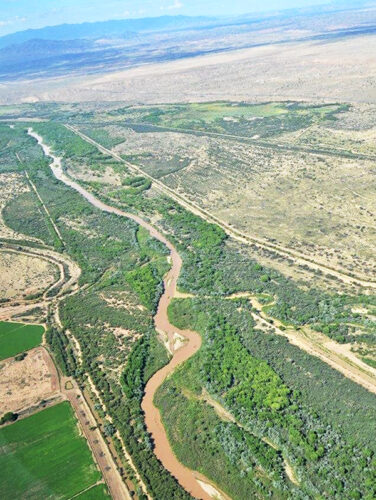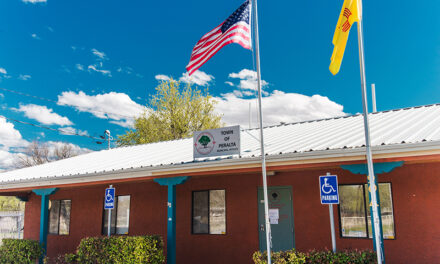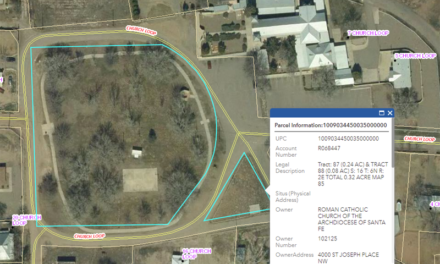Just because there’s been some rain recently doesn’t mean irrigators can breath easy.
“We get a little moisture and it seems like the drought is in the rearview. That’s just not true,” said Jason Casuga, the CEO and chief engineer for the Middle Rio Grande Conservancy District.
In late May, Casuga announced the district would run out of water for irrigators around the middle of June. That prediction held true, with any water going to crops in Valencia County and throughout the district coming directly from Mother Nature.
“From an overall delivery standpoint, the rain has provided water to irrigators. It’s been dropped directly on their property,” Casuga said shortly before the Fourth of July weekend.
The rainfall has lowered MRGCD demand and put water in the river, he said, which are good things, but farmers are nowhere near out of the woods, he added.
“We are still completely reliant on Mother Nature at this time. If it stops, we are going to be back where it was right before the rain, with the river drying and a diminished ability to deliver water,” the chief engineer said. “We’re on the razor’s edge. If we keep getting rain every other week or so, folks will squeak by. If it disappears, we’re going to be in trouble. Periods of moisture in a drought doesn’t change the overall, bigger picture.”
In addition to little surface water in the Rio Grande, the district is also up against the challenge of a major renovation of El Vado Dam, the structure that creates the reservoir where the district can typically store water for dry years.
In a November 2021 Albuquerque Journal article, Theresa Davis reported a U.S. Bureau of Reclamation study said the current dam, built in 1935 on the Rio Chama in Rio Arriba County, poses risks to the public.
“Seepage through the embankment, both through cracks in the steel faceplate and through the foundation of the dam, has led to high seepage losses,” the study said. “The steel liner of the service spillway has similarly deteriorated and is no longer safe to operate.”
As the project progresses, Casuga said the district could have partial storage in 2024, with the total rehab project anticipated to wrap up close to 2026.
“It’s a pretty extensive rehab; they are working from the bottom up. Once it gets higher, they can put water into the reservoir,” Casuga said. “But, even if the dam was fixed today, as a state, New Mexico is under (storage) restrictions in the Rio Grande compact which prohibits storage. We could conceivably get to ’24 or ’26 and still be prohibited from storing. That’s the worst case scenario.”

News-Bulletin file photo
The Rio Grande is drying and has a diminished ability to deliver water. Because of the Rio Grande compact, an agreement with Colorado, Texas and Mexico, the state is under storage restrictions.
At the end of 2021, the state’s compact debt to Texas was about 127,000 acre feet. The compact is an interstate and international water sharing agreement between New Mexico, Colorado, Texas and Mexico, which guarantees surface water will flow from one jurisdiction to the next. The total water debt to Texas for this year won’t be known until the end of the year.
“The best advice I can give folks who farm both as a livelihood and a passion is, there’s nothing they can do today to help with this year but they can take action for next year,” Casuga said.
He advises farmers throughout the district to look at their farms’ efficiency and make decisions, like whether to install a drought relief well, and the overall efficiency of the operation for coming years.
“We may get some breaks and have some really good years. This is the third bad year in a five-year period. In the past, when we’ve been planning, we were assuming two bad years in five,” he said. “Now we’re predicting three bad years in five. There’s very little people can do right now if they haven’t prepared.”
One way farmers can prepare, albeit an unpopular one with most irrigators, is to take part in the district’s voluntary fallowing program, which essentially pays a landowner not to irrigate their property for a growing season.
This irrigation season marks the second year of the district’s voluntary fallowing program, funded by $15 million in federal dollars allocated by the state. In 2021, about 760 agricultural acres were idled, with owners receiving $300 per acre. This year, there are about 2,600 acres in the program at $425 per acre.
The program is closed for 2022, but farmers can use it next year.
“The reality is folks have demonized it but if you want to make some improvements, in the dollar amounts that will move the needle, this could help do that,” Casuga said. “What New Mexico and the Rio Grande area are going through is the same as the greater Southwest. There’s a whole region of the United States grappling with this.
“By the time it’s over, the whole Southwest is going to have to change how it looks at water and how farming should be done in New Mexico. We have to start changing now.”
Julia M. Dendinger began working at the VCNB in 2006. She covers Valencia County government, Belen Consolidated Schools and the village of Bosque Farms. She is a member of the Society of Professional Journalists Rio Grande chapter’s board of directors.
















